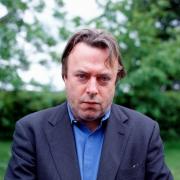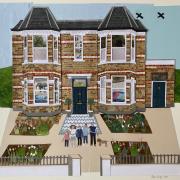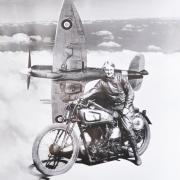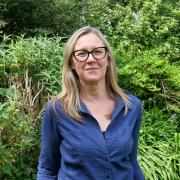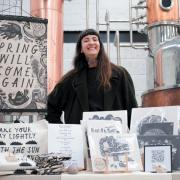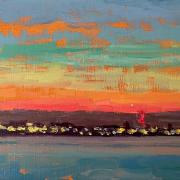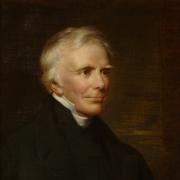On the 150th anniversary of his death, we look back at Charles Dickens’ links to his Portsmouth birthplace.

A foremost social critic and reformer who entertained live audiences with readings, a letter writer par excellence, a celebrity before the word was invented, someone who had a literary term named after him; he was all of these things, and a pretty useful writer too. His name was Charles John Huffam Dickens (1812-70). As we mark the 150th anniversary of Dickens’ death on 9 June, it’s time to consider what it meant (or means) to be Dickensian.
Charles’ father brought his young wife, Elizabeth, to Portsmouth in the summer of 1809, renting a modest house in Old Commercial Road as the first home of their married life. It was a new build, constructed around 1808. Charles was born at this house in Landport, then a small suburb of Portsmouth (or Portsea), on a Friday in the spring of 1812. Apparently, his mum was at a dance at the Beneficial Hall, in Kent Street, that evening, 6 February, but left earlier than planned. Charles emerged the following morning. He was baptised in St Mary’s Church, Fratton Road on 4 March, a Norman church twice replaced by the Victorians, although you’ll have to go to St Alban’s Church, in Copnor Road to see the actual 15th century font that was used.
The Old Commercial Road house wasn’t Charles’ home for long as the family moved to 16 Hawke Street, Portsea four months later in June 1812. Sadly, this house was damaged by World War II bombing and later demolished. There’s a plaque on the George pub, on the corner of Hawke and George Streets. There was one further Portsmouth house, 38 Wish Street, Southsea (today’s King’s Road), where the Dickens lived from Christmas 1813, an unhappy spell, as Charles’ brother Alfred died here aged just five months.
Charles’ father, John, was a clerk in the Navy Pay Office between 1807 to 1814, so attached to Portsmouth Dockyard, when the Navy was still at war with Napoleonic France. This building now houses part of the reserve collection of artefacts belonging to the Mary Rose Trust. He was transferred to London about a year later in 1814, then Chatham in 1816, where Charles, already an avid reader, began his schooling.

The family was in trouble in 1821, by which time Charles was nine. Dad had lost his position and most of his income. A small house in Camden Town, London awaited, but John was soon arrested for debt, carted off to the Marshalsea prison, with son Charles, a smallish lad of ten, heading for a blacking factory, near today’s Charing Cross station. The youngster was busily pasting labels on jars of shoe polish, with a four-mile walk back to his ‘lonely bedroom’ in Camden Town. The fact Charles was not privileged makes his achievements all the greater.
Charles was not just a writer, but also a journalist and editor. Three or four years after his spell in the Marshalsea – an occurrence that scarred the consciousness of the young Charles – Dad got him a position as a reporter. Charles taught himself shorthand and caught up on his reading at the British Library. Aged 16, he was a reporter at Doctors’ Commons (a society of lawyers), before getting permanent employment as a reporter at a London paper.
Charles’ love life could have come from a book. In April 1836 he wed Catherine Hogarth (1815-79). They had ten children between 1837 and 1852. Separation occurred in 1858 after Charles began seeing the young actress Ellen Ternan (1839-1914), who was 18 to Charles’ 45, when they met. Separation contravened Victorian mores but was preferable to divorce, which was scandalous. Ellie was Charles’ mistress between 1857 and 1870 and is perhaps the most prominent of the Dickens- related graves in Portsmouth’s Highland Road Cemetery. The author’s first love Maria Beadnell is also buried there, a lady who inspired the character of Dora in David Copperfield.
While we associate Charles with our own capital, he actually travelled quite widely. Once established as a famous writer, he headed to America (1842 and 1867-68), the latter being the more satisfactory of the two trips from his perspective. He lectured, complained about his work being pirated, and gave public readings of his prose. Protecting copyright certainly featured in Dickens’ career. Sketches by Boz were collected and published early in 1836, with Charles receiving £150 for the copyright. He’d later buy it back for 11 times that figure. Charles also travelled in Europe.

Charles’ lesser-known but lucrative public readings occurred between 1858 and 1870 in the UK and America. Plaques abound recording that ‘Dickens gave his readings here’. Charles gave readings in his home city, at St George’s Hall in St George’s Square, in November 1858, and May 1866, to popular acclaim.
Charles was far more than an author: add in private theatricals (his early ambitions had been towards acting), speeches, letters too many to count, pamphlets, plays, and running a periodical: Household Words in 1850, then All the Year Round in 1859.
Charles was taken from us prematurely. He died on 9 June 1870, aged 58. It was the fifth anniversary of the Staplehurst rail crash, in which he was a passenger. In a tragedy presaging the 1879 Tay Bridge disaster, seven carriages fell from a cast-iron bridge that was under repair. Ten passengers died in the calamity, which may have hastened Charles’ decline. Although he used the railways in his subsequent writing (such as The Signal-Man in 1866), he remained a nervous passenger. He was also a workaholic, which may also have contributed.
Did Charles’ Hampshire origins influence his writing? Yes, is the simple answer. In Nicholas Nickleby, the eponymous hero and Smike find lodgings above a tobacconist’s on the Hard, just outside Portsmouth Dockyard’s main gate. The Portsmouth Theatre, in the High Street, inspired the location where the company of Vincent Crummles performed in the novel. The real theatre closed in 1854, being replaced by the Cambridge Barracks, occupied by Portsmouth Grammar since 1926.

Charles’ birthplace has been in the care of Portsmouth City Council since 1903 and is today a museum, which opened in 1953 and has recently been awarded national accreditation status by Arts Council England. A blue plaque, placed by the Portsmouth Branch of the Dickens Fellowship Society in 1978, records his birth. The fixtures and fittings faithfully recreate the Regency style Charles’ parents appreciated, although their own possessions are now dispersed far and wide. There are three furnished rooms – the parlour, dining room and bedroom where Charles was born – plus an exhibition room with displays on the author and city, and a small collection of memorabilia, including the couch on which he died at his Kent home, and his snuff box, inkwell and paper knife. Sometimes it’s the smaller, more intimate items that add poignancy.







